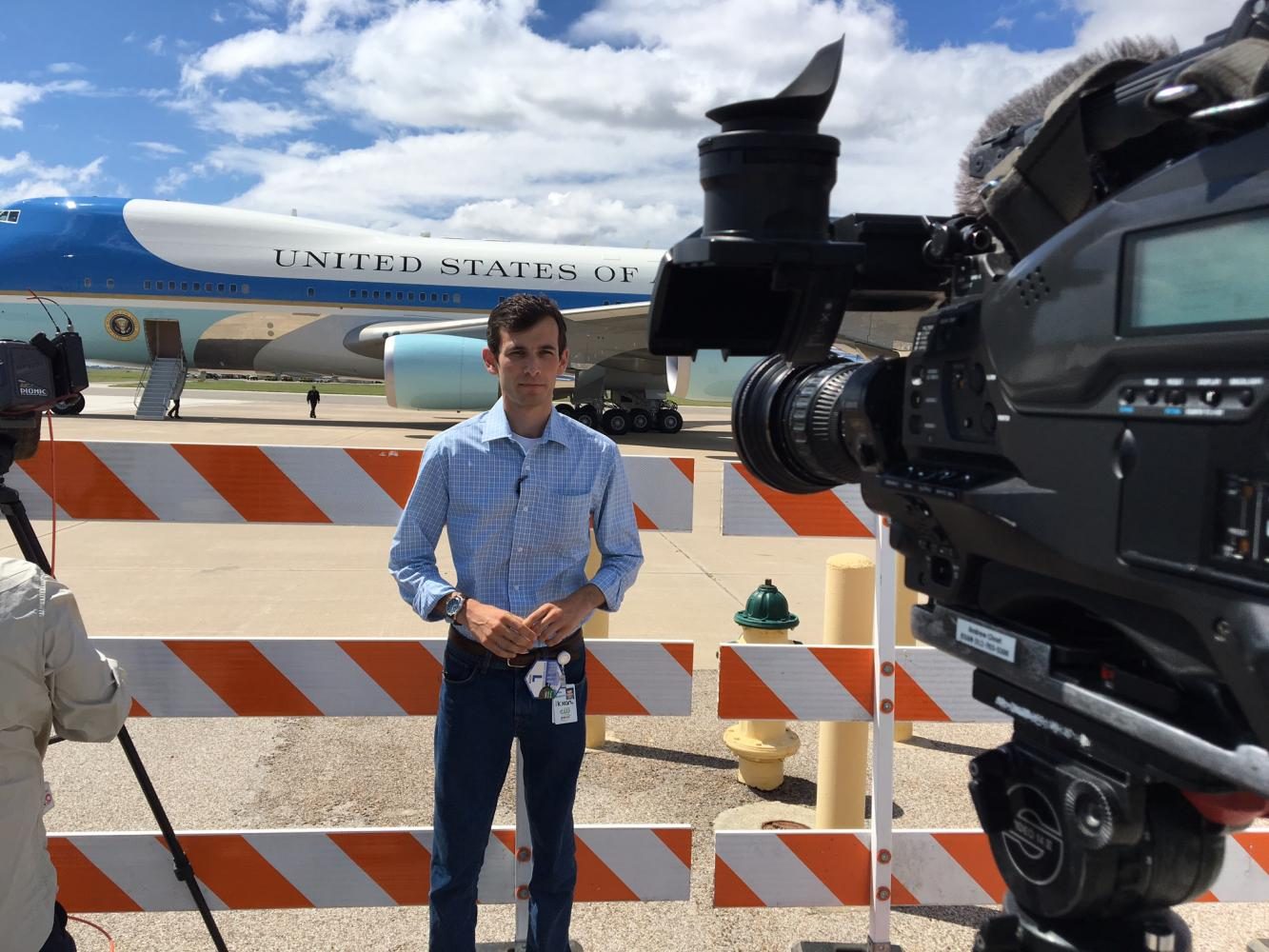Texas recovering in aftermath of Harvey’s devastation
Courtesy of Nexstar/Frank Martinez
Capitol Correspondent at Nexstar Austin Bureau Wes Rapaport reports on President Trump’s visit to Corpus Christi at the Corpus Christi International Airport. Trump arrived to meet with local and state officials on Tuesday.
September 6, 2017
Tropical storm Hurricane Harvey is currently causing severe flooding and water damage in southeastern Texas and nearby areas, including Oklahoma, Arkansas, Louisiana and Mississippi.
The hurricane developed from a tropical wave near the Caribbean Islands on Aug. 17 and rapidly intensified into a Category 4 storm after moving northwest past Barbados. It hit Rockport, Texas, at peak strength around 10 p.m. CST two weeks ago on Friday. The National Weather Service announced last Tuesday night that Harvey will reach the Texas-Louisiana state line after 12 a.m. CST.
As of last Wednesday night, Texas officials estimate at least 38 casualties as a result of the storm. The first was reported in Rockport after a city resident died in a house fire caused by the hurricane. After sending strong winds of over 130 mph through Rockport and moving further inland, Harvey devolved into a Category 1 storm by last Saturday.
“There was no evacuation, but I did hear of some dorms or commons being flooded with some water leaking in and a fire alarm going off because of electrical problems. They just [had] to evacuate us to a servery, a kind of cafeteria we have, or to another college or something, but mostly the college is fine,” Rice University freshman Vienna Wang (‘17) said. “I think Rice is built as a quite stable university; we’re built on higher ground and our buildings are strong. Mostly, there is just flooding water from the doors, so we just have to mop that up and stuff.”
According to city officials, around 5,500 individuals are currently situated at shelters in Houston. However, many more may be displaced from their homes as heavy rains and flooding continue to impact the metropolitan Houston area of more than 6.5 million people. While some areas are currently receiving around 20 inches of rain, Houston can expect to see 50 or more in the coming days.
In a news conference last Wednesday, Houston Mayor Sylvester Turner expressed his wishes for Houston to recover as quickly as possible. Houston’s airports reopened at 4 p.m. CST and schools will resume classes on Sept. 5.
Throughout the last three weeks, the NWS has been warning the public of the dangers and impacts of Hurricane Harvey. On Monday, they added a new color to their charts to more effectively monitor and gauge the extent of Texas’ precipitation.
“This event is unprecedented & all impacts are unknown & beyond anything experienced. Follow orders from officials to ensure safety. #Harvey,” the NWS tweeted on Sunday.
Search and rescue efforts began last Sunday when military vehicles and helicopters began rushing in to help local police locate hurricane victims. At least two Bay Area rescue teams consisting of firefighters from Menlo Park, San Mateo, Burlingame, Palo Alto, San Jose and Oakland were also dispatched to Texas after receiving calls for help in the area on Sunday morning. On Wednesday, Texas Gov. Greg Abbott announced that around 24,000 National Guard members would be deployed at the area. Since the beginning of the storm, they have already conducted 8,500 rescues.
“Texas truly appreciates the support from across the country like these national guard members from Alaska & California. #HurricaneHarvey,” Gov. Abbott tweeted on Wednesday afternoon.
To aid victims of Hurricane Harvey, Mayor Turner established a relief fund at the Greater Houston Community Foundation. GoFundMe, the Salvation Army and the Red Cross have also been contributing to relief efforts by creating a charities hub page, providing food and water to those affected and accepting blood donations. Cash donations are preferable for organizations, such as Central Texas Food Bank, to purchase most beneficial disaster relief aids. As Upper School theater teacher Jeffrey Draper announced during last Tuesday’s school meeting, the performing arts department is currently considering setting up ticket sales for the Fall Play as a school charity for Hurricane Harvey.
“You drive around afterward and you see what was left. . . you’ve got roofs that were ripped off. You’ve got people sifting through what’s left of their lives,” Wes Rapaport, a Capitol Correspondent at the Nexstar Austin Bureau, said. “What we didn’t see was people who had given up.”
Harvey is the first major, or Category 3 and higher, hurricane to reach and continue over United States land since Hurricane Ike in 2008, a Category 4 storm that also heavily impacted southeastern Texas.
A shorter version of this piece was published in the pages of the Winged Post on September 6, 2017.
Correction: September 6, 2017
The Winged Post version of this piece incorrectly attributed the article to staff writers Nicole Chen and Rose Guan. This online version correctly attributes the article to staff writers Tiffany Wong and Gloria Zhang.


















![“[Building nerf blasters] became this outlet of creativity for me that hasn't been matched by anything else. The process [of] making a build complete to your desire is such a painstakingly difficult process, but I've had to learn from [the skills needed from] soldering to proper painting. There's so many different options for everything, if you think about it, it exists. The best part is [that] if it doesn't exist, you can build it yourself," Ishaan Parate said.](https://harkeraquila.com/wp-content/uploads/2022/08/DSC_8149-900x604.jpg)




![“When I came into high school, I was ready to be a follower. But DECA was a game changer for me. It helped me overcome my fear of public speaking, and it's played such a major role in who I've become today. To be able to successfully lead a chapter of 150 students, an officer team and be one of the upperclassmen I once really admired is something I'm [really] proud of,” Anvitha Tummala ('21) said.](https://harkeraquila.com/wp-content/uploads/2021/07/Screen-Shot-2021-07-25-at-9.50.05-AM-900x594.png)







![“I think getting up in the morning and having a sense of purpose [is exciting]. I think without a certain amount of drive, life is kind of obsolete and mundane, and I think having that every single day is what makes each day unique and kind of makes life exciting,” Neymika Jain (12) said.](https://harkeraquila.com/wp-content/uploads/2017/06/Screen-Shot-2017-06-03-at-4.54.16-PM.png)








![“My slogan is ‘slow feet, don’t eat, and I’m hungry.’ You need to run fast to get where you are–you aren't going to get those championships if you aren't fast,” Angel Cervantes (12) said. “I want to do well in school on my tests and in track and win championships for my team. I live by that, [and] I can do that anywhere: in the classroom or on the field.”](https://harkeraquila.com/wp-content/uploads/2018/06/DSC5146-900x601.jpg)
![“[Volleyball has] taught me how to fall correctly, and another thing it taught is that you don’t have to be the best at something to be good at it. If you just hit the ball in a smart way, then it still scores points and you’re good at it. You could be a background player and still make a much bigger impact on the team than you would think,” Anya Gert (’20) said.](https://harkeraquila.com/wp-content/uploads/2020/06/AnnaGert_JinTuan_HoHPhotoEdited-600x900.jpeg)

![“I'm not nearly there yet, but [my confidence has] definitely been getting better since I was pretty shy and timid coming into Harker my freshman year. I know that there's a lot of people that are really confident in what they do, and I really admire them. Everyone's so driven and that has really pushed me to kind of try to find my own place in high school and be more confident,” Alyssa Huang (’20) said.](https://harkeraquila.com/wp-content/uploads/2020/06/AlyssaHuang_EmilyChen_HoHPhoto-900x749.jpeg)







